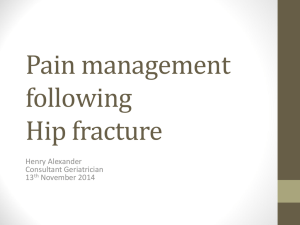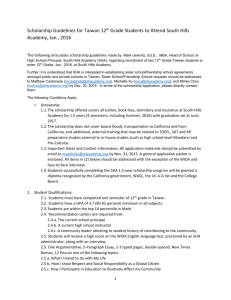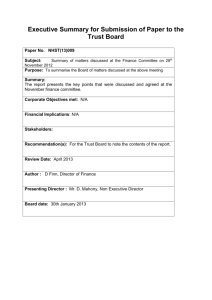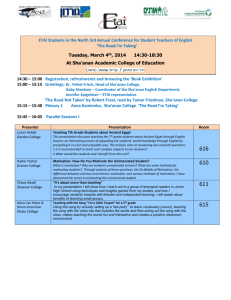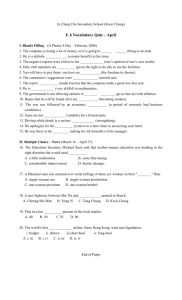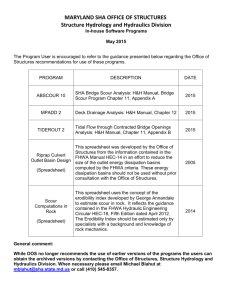Karnataka Health System Development and Reform Project
advertisement
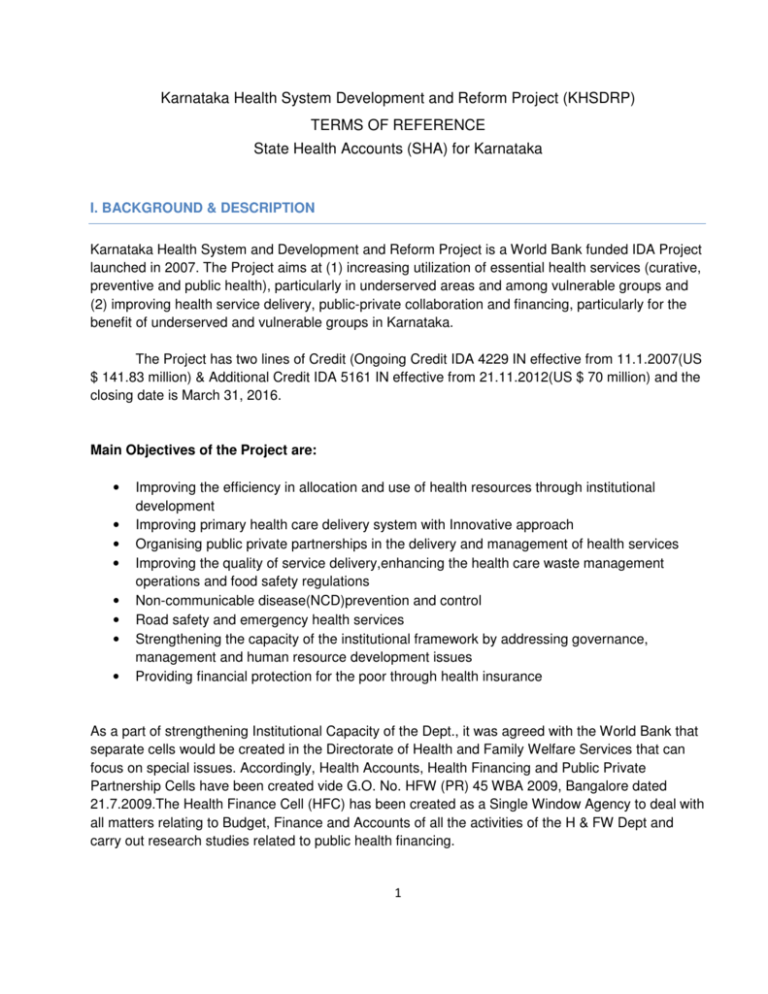
Karnataka Health System Development and Reform Project (KHSDRP) TERMS OF REFERENCE State Health Accounts (SHA) for Karnataka I. BACKGROUND & DESCRIPTION Karnataka Health System and Development and Reform Project is a World Bank funded IDA Project launched in 2007. The Project aims at (1) increasing utilization of essential health services (curative, preventive and public health), particularly in underserved areas and among vulnerable groups and (2) improving health service delivery, public-private collaboration and financing, particularly for the benefit of underserved and vulnerable groups in Karnataka. The Project has two lines of Credit (Ongoing Credit IDA 4229 IN effective from 11.1.2007(US $ 141.83 million) & Additional Credit IDA 5161 IN effective from 21.11.2012(US $ 70 million) and the closing date is March 31, 2016. Main Objectives of the Project are: • • • • • • • • Improving the efficiency in allocation and use of health resources through institutional development Improving primary health care delivery system with Innovative approach Organising public private partnerships in the delivery and management of health services Improving the quality of service delivery,enhancing the health care waste management operations and food safety regulations Non-communicable disease(NCD)prevention and control Road safety and emergency health services Strengthening the capacity of the institutional framework by addressing governance, management and human resource development issues Providing financial protection for the poor through health insurance As a part of strengthening Institutional Capacity of the Dept., it was agreed with the World Bank that separate cells would be created in the Directorate of Health and Family Welfare Services that can focus on special issues. Accordingly, Health Accounts, Health Financing and Public Private Partnership Cells have been created vide G.O. No. HFW (PR) 45 WBA 2009, Bangalore dated 21.7.2009.The Health Finance Cell (HFC) has been created as a Single Window Agency to deal with all matters relating to Budget, Finance and Accounts of all the activities of the H & FW Dept and carry out research studies related to public health financing. 1 The State Government proposes to develop State Health Accounts estimates for Karnataka for the years 2012-13, 2011-12, 2010-11on lines with the National Health Accounts framework. The activity will be funded under the World Bank project being implemented by the State Government. What is State Health Accounts (SHA)? State Health Accounts (SHA) is an effective tool specifically designed for policy makers and managers of the health care sector. By providing a matrix on the sources and uses of funds for health, the SHA framework facilitates in tracing how resources are mobilized and managed, who pays and how much is paid for healthcare, who provides goods and services, how resources are distributed across services, intermediaries and activities the health system produces. SHA provides the information and estimates of what happenstothe expenditure flows in the health sector across public, private, voluntary sectors in the state. SHA Karnataka will attempt to explain the health accounts of Karnataka through a set of tables that organize, tabulate and present health expenditure by identifying the linkages between sources, agents, providers and functions using a standard system of matrices, following the National Health Accounts methodology. The flow of funds reflected in the matrices trace the manner in which resources are mobilized and distributed across different entities, interventions and activities in the health system. II. RATIONALE FOR STATE HEALTH ACCOUNTS Health Accounts is a tested and internationally accepted tool to estimate and mapa Nation’s / State’s health expenditure. At the national level, the first Health Accounts for India was developed for the fiscal year 2001–02 (NCMH 2005, MOHFW 2006). The second in the series was prepared for the fiscal year 2004–05with estimates available till 2008-09 (MOHFW 2009). In the Indiancontext, SHA becomes much more important because majority of policy decisions pertaining to resource allocation in the health sector are made at the state level. SHA provides policy-makers reliable state-level information on the sources and uses of funds for health depicting the current use of resources in the health system.SHA traces the expenditure flows in the health sector across public, private, voluntary and external sectors in the state. SHA can provide a basis for tracking internal and external resources contributing to the health sector. Health accounts can facilitate monitoring the implementation of resources within health financing initiatives of the state, and they can help track use of resources to achievethe Millennium Development Goals and other global initiatives, the importance and usefulness of SHA in revamping health care financing strategies becomes much more meaningful to policy makers, administrators and researchers in analyzing health expenditure and the direction in which financing health care in Karnataka would need to move in future. By delineating the amount being spent out-of-pocket by households, it can also measure and track progress in financial protection. By estimating the share of expenses on different types and levels of providers, it can contribute to allocation decisions for public funds. 2 III. SPECIFIC OBJECTIVES The SHA estimates for Karnataka will provide appropriate answers to policy-level questions such as below: (i) Who pays and how much do they pay for health? (ii) Who are the important actors in health financing and health care delivery and how significant are their contributions in terms of their share in thetotal expenditure? (iii) How health fundsare distributed across different services, providers, interventions, and activities that the health system produces? SHA will produce useful evidence for decision regarding the allocation of resources and priority setting in public health financing in Karnataka. Further the SHA could also provide information of the public expenditure across the districts, how much is the expenditure by district especially of public sector, what is the relative size of the private sector etc. IV. SCOPE AND COVERAGE OF THE STUDY The SHA will cover all the public expenditure on health in Karnataka i.e., by Central Government, State Government, Local Bodies (Urban Local Bodies and Rural Local Bodies), Other State Departments, money from External / Foreign Agencies going through the government as an intermediary, Social Insurance Schemes etc., as well as all private expenditure on health i.e., by NGOs(including expenditure incurred by religious bodies both as a source of financing and providing services, such as devasthanams, maths, gurudwara, muslim organizations, missionary organizations and other non-profit or faith based organizations. Firms (publicly owned, private firms, including small and medium enterprises.), commercial insurance companies and payments made by Households. In addition to state health accounts, the agency should also create District Health Accounts for two specified districts in Karnataka. The compilation of District Health Accounts would give a picture of Health expenditure right from the state to the district level. Further though the major component would be the out of pocket expenditure which could constitute a large share of the health financing in the state, since primary data collection to collect household expenditure is not envisaged (except for small surveys that may be needed for validation checks or for making certain assumptions regarding household expenditure), this would use existing datasets from NSSO and other sources. This would involve taking the NSSO 60th round data as well as subsequent rounds of NSSO, and making estimatesfor current periods in line with standard NHA methodology. 3 SHA Entities and Matrices For the purpose of SHA, health expenditures are calculated and structured on the basis of the entities constituting the system of flow of funds. The SHA framework has four principal entities; Financing Sources, Financing Agents, Providers and Functions, in a health system, which are coded and classified according to the International Classification of Health Accounts (ICHA). SHA tracks flow of funds across the health system starting from financing sources to the end point i.e. functions.SHA attempts at explaining the health accounts of the given state or country through a set of tables that organizes tabulates and presents health expenditure by identifying the linkages between sources, agents, providers and functions through a system of matrices. The flow of funds reflected in the matrices trace the manner in which resources are mobilized and distributed across different entities, interventions and activities in the health system. V. OUTLINE OF TASKS TO BE PERFORMED BY THE CONSULTANT Sl. No. 1 Description Submit the plan of action which constitutes the following: • Identification of data sources: all the data sources, public, private, external etc. • Process of collecting the data for each of the sources, data collectiontools and templates and the time line • The research design, sample, methodology and analysis 2. Review of activity plan for SHA Karnataka with timeline / schedule and submission of inception report 3. Collect & review the public health expenditure data for the years 2012-13, 2011-12 and 2010-11from various sources available in the State of Karnataka or elsewhere including the data compiled for the National Health Accounts 2001-02 and 2004-05, and identify missing data or gaps therein. 4. Draft questionnaires and conduct survey for SHA for private sector entities (NGOs, Firms, Insurance Companies) and for any missing information on public expenditure. Households / Out-of-pocket by survey method or utilizing recent NSSO data.Analyze the questionnaire data where received, for arriving at the required expenditure estimates. 5. Compile and analyze all information collected in accordance with the NHA methodology and ICHA to create the SHA matrices, clearly outlining each step in the methodology and all the assumptions made at every stage of the process. Submission of detailed documentation on methodology and assumptions will be mandatory to allow payments for this and subsequent milestones. 6. Submit the preliminary analysis and interim report to the stakeholders 7. Co-ordinate with HFC Consultants for monitoring and evaluation of all the tasks performed during SHA exercise, including random checks of survey data, detailed check of the analysis performed and review 4 of the validity of the assumptions made. 8. Any other miscellaneous items linked to the SHA study as may be advised by the DoHFW or World Bank from time to time. 9. Capacity building/Training of the HFA Cell and department officials. 10. 11. 12. 13. Generate a draft SHA report based on the matrices, including sections on methodology, key findings and policy implications of the SHA study. Participate in workshops organized by HFC for discussion of the study with stakeholders. Prepare and submit MS Excel template / model and train the relevant officials so that they can update the SHA exercise for subsequent years Participate in the peer review process arranged by the HFC and the World Bank, and make suitable revisions as suggested in the peer review Finalize the report & presentation slides for findings and key recommendations and submit the same VI. OUTPUT TO BE DELIVERED BY CONSULTANT WITH TIMELINE Report 1.1: Inception Report with proposed methodology and tools/questionnaires for review Report 1.2: The consultancy will deliver a brief report on all the public data collected and materials that they have examined and that they propose to use for the various steps. This will be done within 2 months of signing the contract agreement. Report 2: The consultancy will deliver a brief report on all the private data collected and materials that they have examined and that they propose to use for the various steps. This will be done within 5 months of signing the contract agreement. This will also include a template in excel spreadsheet linking budget codes to International Classification of Health Accounts (ICHA). Reports 3: An interim report should be submitted within7 months of the signing of contract indicating the approach to the SHA with the framework of the chapters and the source materials analyzed. At this stage clarity must be demonstrated in the way objectives, programmes, activities, outputs and outcomes are being linked along with expenditure outlays. Clarity must also be demonstrated about the way resource envelopes are being enlisted and analysed. Report 4.1 Draft Report: Within 9 months of signing the contract agreement. This will include the tables, matrices linking Financing Sources, Financing Agents, Provider, Function and spreadsheets 5 linking objectives, programmes and activities and expenditure levels to outputs and outcomes as per NHA framework. The Draft report must be complete in all respects. Report 4.2 Draft final report: Within 3 Weeks of the receipt of comments from the State Government/ KHSDRP. (The State Government/KHSDRP will give the comments within 4 weeks of its receipt by them) Report 4.3 Final Report: within 3 weeks of the receipt of the final comments from the State Government / KHSDRP. In addition to the above mentioned deliverable’s consultancy would be involved in developing capacities of the HFA cell. This can be achieved by building systems for data feeding even after the project is completed so that the data keeps flowing in and the HFA cell will be able to come out with estimates for later periods. The estimates prepared would be reviewed by the steering committee on a regular basis. The frequency of the meetings would be decided by the steering committee members. Further the estimates provided by the agency would be cross checked by the team of experts and their feedback and comments need to be incorporated as and when required. NOTES: 1. All expenditure data must be collected for a period of three years i.e., FY 2010-11, 2011-12 and 2012-13 2. All data must be posted in excel spreadsheets and explanatory notes should be given for all cell formulas used. 3. All Tables and graphs must be duly explained with a write up on how to use them. They must be built in excel spreadsheet. 4. Sources of all data and facts must be quoted. If the data from source has been processed in any form and then represented or given in the report then an explanatory table and note should be given on how this has been done. All such analysis must be done on excel spreadsheets and soft copy of the analysis must be invariably provided with due indexation for easy identification and access. 6 VII. KEY PERSONNEL KEY PERSONNEL Preferred Background Minimum Man power requiredat any time during the contract (In Nos.) Sr. Health Economist Post Graduate degree in Economics or Management or hospital Administration with 7 years of relevant experience of which at least 3 years as Team Leader of assignments of similar nature 1 12 12 NHA Domain Expert Should have been a team member or advisor in undertaking NHA studies in India / international level or having published NHA studies in reputed journals. 1 At least 2 months At least 2 months Data Manager / Coordinator Degree in any discipline with 3 years of experience in running analytical reports and queries related to health sector. 1 12 12 Months of Servicerequi red (In Nos.) Total Man Months of Service required (In Nos.) VIII. PROJECT REVIEW COMMITEE A review committee consisting of following officers shall review the progress of the work and the reports submitted by the Consultancy: 1. 2. 3. 4. 5. Project Administrator, KHSDRP and Mission Director, NRHM JD(Planning), Health and Family Welfare Department Chief Administrative Officer, KHSDRP CFO KHSDRP and NRHM, Member Secretary Technical expert to be nominated by Project Administrator. 7

